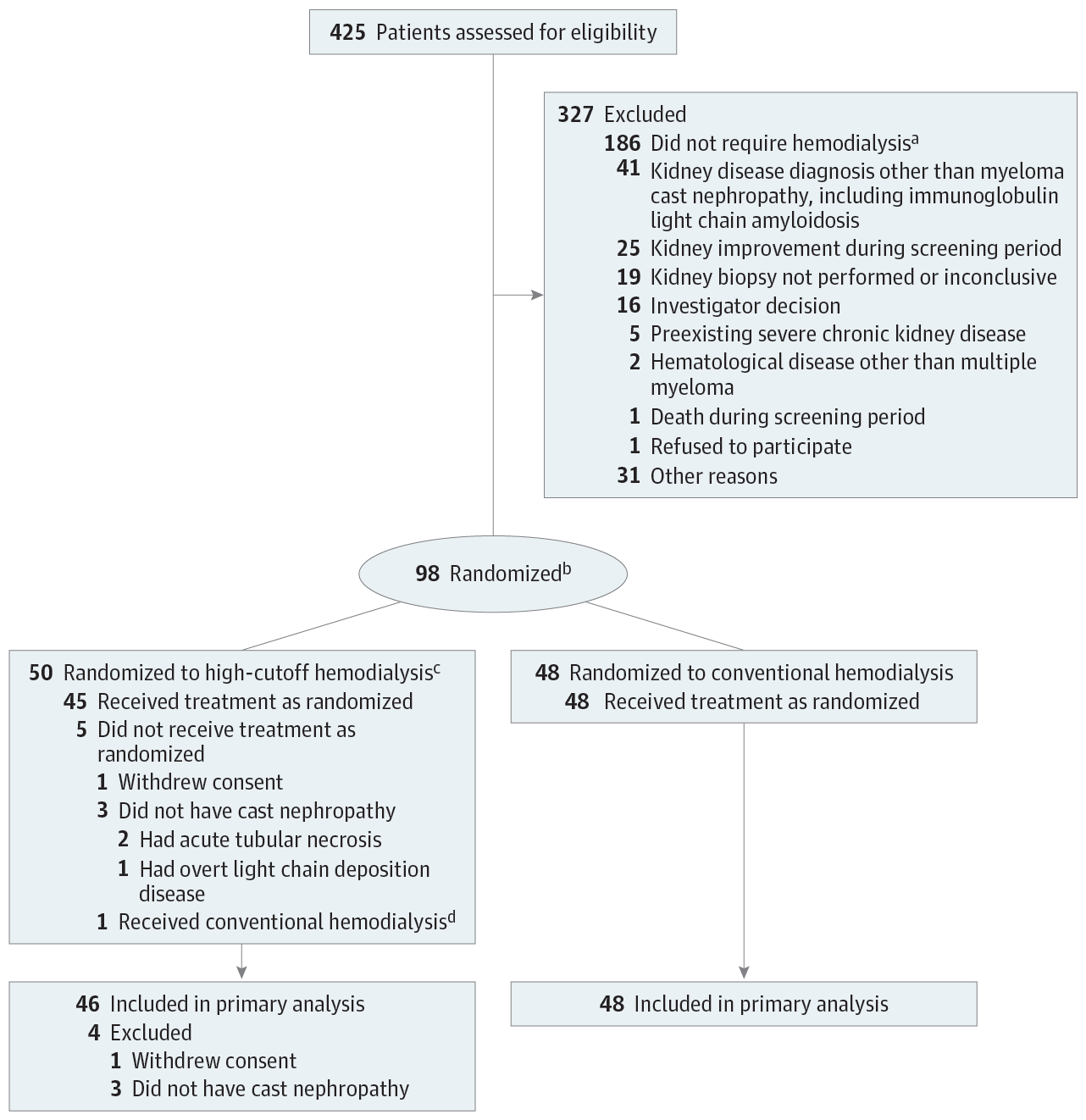Our official English website, www.x-mol.net, welcomes your
feedback! (Note: you will need to create a separate account there.)
Effect of High-Cutoff Hemodialysis vs Conventional Hemodialysis on Hemodialysis Independence Among Patients With Myeloma Cast Nephropathy
JAMA ( IF 63.1 ) Pub Date : 2017-12-05 , DOI: 10.1001/jama.2017.17924 Frank Bridoux 1, 2, 3 , Pierre-Louis Carron 4 , Brigitte Pegourie 5 , Eric Alamartine 6 , Karine Augeul-Meunier 7 , Alexandre Karras 8 , Bertrand Joly 9 , Marie-Noëlle Peraldi 10 , Bertrand Arnulf 11 , Cécile Vigneau 12 , Thierry Lamy 13 , Alain Wynckel 14 , Brigitte Kolb 15 , Bruno Royer 16 , Nolwenn Rabot 17 , Lotfi Benboubker 18 , Christian Combe 19 , Arnaud Jaccard 2, 3, 20 , Bruno Moulin 21 , Bertrand Knebelmann 22 , Sylvie Chevret 23 , Jean-Paul Fermand 11 ,
JAMA ( IF 63.1 ) Pub Date : 2017-12-05 , DOI: 10.1001/jama.2017.17924 Frank Bridoux 1, 2, 3 , Pierre-Louis Carron 4 , Brigitte Pegourie 5 , Eric Alamartine 6 , Karine Augeul-Meunier 7 , Alexandre Karras 8 , Bertrand Joly 9 , Marie-Noëlle Peraldi 10 , Bertrand Arnulf 11 , Cécile Vigneau 12 , Thierry Lamy 13 , Alain Wynckel 14 , Brigitte Kolb 15 , Bruno Royer 16 , Nolwenn Rabot 17 , Lotfi Benboubker 18 , Christian Combe 19 , Arnaud Jaccard 2, 3, 20 , Bruno Moulin 21 , Bertrand Knebelmann 22 , Sylvie Chevret 23 , Jean-Paul Fermand 11 ,
Affiliation

|
Importance Cast nephropathy is the main cause of acute kidney injury in multiple myeloma and persistent reduction in kidney function strongly affects prognosis. Strategies to rapidly remove nephrotoxic serum-free light chains combined with novel antimyeloma agents have not been evaluated prospectively. Objective To compare the hemodialysis independence rate among patients newly diagnosed with myeloma cast nephropathy treated with hemodialysis using a high-cutoff dialyzer (with very large membrane pores and high permeability to immunoglobulin light chains) or a conventional high-flux dialyzer (with small pores and lower permeability). Design, Setting, and Participants Randomized clinical trial involving 98 patients with biopsy-proven myeloma cast nephropathy requiring hemodialysis treated at 48 French centers between July 2011 and June 2016; the final date of follow-up was June 29, 2016. Interventions Intensive hemodialysis (eight 5-hour sessions over 10 days) with either a high-cutoff dialyzer (46 patients) or a conventional high-flux dialyzer (48 patients). All patients received the same chemotherapy regimen of bortezomib and dexamethasone. Main Outcomes and Measures Primary end point was hemodialysis independence at 3 months; secondary end points: hemodialysis independence rates at 6 and 12 months, hemodialysis- and chemotherapy-related adverse events, and death. Results Among 98 randomized patients, 94 (96%) (median age, 68.8 years [interquartile range, 61.2-75.3 years]; 45% women) were included in the modified intent-to-treat analysis. The hemodialysis independence rate at 3 months was 41.3% (n = 19) in the high-cutoff hemodialysis group vs 33.3% (n = 16) in the conventional hemodialysis group (between-group difference, 8.0% [95% CI, −12.0% to 27.9%], P = .42); at 6 months, the rate was 56.5% (n = 26) vs 35.4% (n = 17), respectively (between-group difference, 21.1% [95% CI, 0.9% to 41.3%], P = .04); and at 12 months, the rate was 60.9% (n = 28) vs 37.5% (n = 18) (between-group difference, 23.4% [95% CI, 3.2% to 43.5%], P = .02). The incidence of hemodialysis-related adverse events was 43% in the high-cutoff hemodialysis group vs 39% in the conventional hemodialysis group; chemotherapy-related serious adverse events, 39% vs 37%, respectively; and at 12 months, 9 patients vs 10 patients died. Conclusions and Relevance Among patients with myeloma cast nephropathy treated with a bortezomib-based chemotherapy regimen, the use of high-cutoff hemodialysis compared with conventional hemodialysis did not result in a statistically significant difference in hemodialysis independence at 3 months. However, the study may have been underpowered to identify an early clinically important difference. Trial Registration clinicaltrials.gov Identifier: NCT01208818
中文翻译:

高截止血液透析与传统血液透析对骨髓瘤管型肾病患者血液透析独立性的影响
重要性 管型肾病是多发性骨髓瘤急性肾损伤的主要原因,肾功能持续下降强烈影响预后。快速去除肾毒性无血清轻链与新型抗骨髓瘤药物联合的策略尚未进行前瞻性评估。目的 比较新诊断骨髓瘤管型肾病患者采用高截流透析器(膜孔径大、免疫球蛋白轻链通透性高)与传统高通量透析器(膜孔径小、免疫球蛋白轻链通透性高)进行血液透析的独立率。渗透率较低)。设计、背景和参与者随机临床试验,涉及 2011 年 7 月至 2016 年 6 月期间在法国 48 个中心接受治疗的 98 名活检证实的骨髓瘤管型肾病患者,需要进行血液透析;最终随访日期为 2016 年 6 月 29 日。 干预措施 使用高截止透析器(46 名患者)或传统高通量透析器(48 名患者)进行强化血液透析(10 天内 8 次,每次 5 小时)。所有患者均接受相同的硼替佐米和地塞米松化疗方案。主要结果和措施 主要终点是 3 个月时独立进行血液透析;次要终点:6 个月和 12 个月时的血液透析独立率、血液透析和化疗相关的不良事件以及死亡。结果 在 98 名随机患者中,94 名 (96%)(中位年龄,68.8 岁[四分位数范围,61.2-75.3 岁];45% 女性)被纳入修改后的意向治疗分析。高截止血液透析组 3 个月时的血液透析独立率为 41.3% (n = 19),而传统血液透析组为 33.3% (n = 16)(组间差异为 8.0% [95% CI, −12.0] % 至 27.9%],P = .42); 6 个月时,该比率分别为 56.5% (n = 26) 和 35.4% (n = 17)(组间差异,21.1% [95% CI,0.9% 至 41.3%],P = .04); 12 个月时,该比率为 60.9% (n = 28) vs 37.5% (n = 18)(组间差异为 23.4% [95% CI,3.2% 至 43.5%],P = .02)。高截止血液透析组与血液透析相关的不良事件发生率为 43%,而传统血液透析组为 39%;化疗相关的严重不良事件分别为 39% 和 37%; 12 个月时,9 名患者死亡,而 10 名患者死亡。结论和相关性 在接受基于硼替佐米的化疗方案治疗的骨髓瘤管型肾病患者中,与传统血液透析相比,使用高截止血液透析并没有导致 3 个月时血液透析独立性存在统计学上的显着差异。然而,该研究可能不足以确定早期临床上重要的差异。试验注册临床试验。政府标识符:NCT01208818
更新日期:2017-12-05
中文翻译:

高截止血液透析与传统血液透析对骨髓瘤管型肾病患者血液透析独立性的影响
重要性 管型肾病是多发性骨髓瘤急性肾损伤的主要原因,肾功能持续下降强烈影响预后。快速去除肾毒性无血清轻链与新型抗骨髓瘤药物联合的策略尚未进行前瞻性评估。目的 比较新诊断骨髓瘤管型肾病患者采用高截流透析器(膜孔径大、免疫球蛋白轻链通透性高)与传统高通量透析器(膜孔径小、免疫球蛋白轻链通透性高)进行血液透析的独立率。渗透率较低)。设计、背景和参与者随机临床试验,涉及 2011 年 7 月至 2016 年 6 月期间在法国 48 个中心接受治疗的 98 名活检证实的骨髓瘤管型肾病患者,需要进行血液透析;最终随访日期为 2016 年 6 月 29 日。 干预措施 使用高截止透析器(46 名患者)或传统高通量透析器(48 名患者)进行强化血液透析(10 天内 8 次,每次 5 小时)。所有患者均接受相同的硼替佐米和地塞米松化疗方案。主要结果和措施 主要终点是 3 个月时独立进行血液透析;次要终点:6 个月和 12 个月时的血液透析独立率、血液透析和化疗相关的不良事件以及死亡。结果 在 98 名随机患者中,94 名 (96%)(中位年龄,68.8 岁[四分位数范围,61.2-75.3 岁];45% 女性)被纳入修改后的意向治疗分析。高截止血液透析组 3 个月时的血液透析独立率为 41.3% (n = 19),而传统血液透析组为 33.3% (n = 16)(组间差异为 8.0% [95% CI, −12.0] % 至 27.9%],P = .42); 6 个月时,该比率分别为 56.5% (n = 26) 和 35.4% (n = 17)(组间差异,21.1% [95% CI,0.9% 至 41.3%],P = .04); 12 个月时,该比率为 60.9% (n = 28) vs 37.5% (n = 18)(组间差异为 23.4% [95% CI,3.2% 至 43.5%],P = .02)。高截止血液透析组与血液透析相关的不良事件发生率为 43%,而传统血液透析组为 39%;化疗相关的严重不良事件分别为 39% 和 37%; 12 个月时,9 名患者死亡,而 10 名患者死亡。结论和相关性 在接受基于硼替佐米的化疗方案治疗的骨髓瘤管型肾病患者中,与传统血液透析相比,使用高截止血液透析并没有导致 3 个月时血液透析独立性存在统计学上的显着差异。然而,该研究可能不足以确定早期临床上重要的差异。试验注册临床试验。政府标识符:NCT01208818











































 京公网安备 11010802027423号
京公网安备 11010802027423号